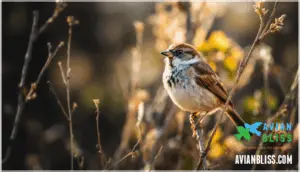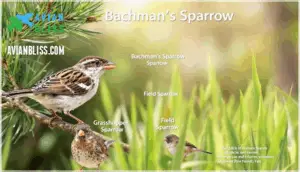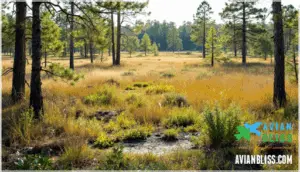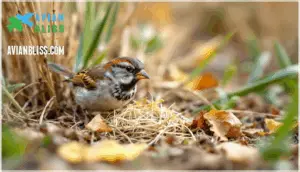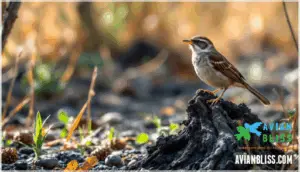This site is supported by our readers. We may earn a commission, at no cost to you, if you purchase through links.
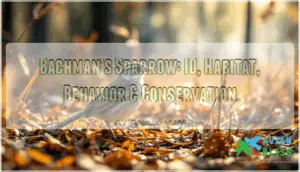
This reddish-brown sparrow, roughly the size of your palm, depends on a disappearing world: open pine forests with grassy floors maintained by fire. Most birdwatchers spend years searching for this elusive ground-dweller, which prefers to skulk beneath wiregrass and scrub rather than perch in plain view.
Understanding what makes this sparrow tick—its habitat needs, distinctive song, and ecological role—reveals why protecting it means preserving an entire vanishing ecosystem.
Table Of Contents
- Key Takeaways
- Bachman’s Sparrow Identification Guide
- Habitat and Range of Bachman’s Sparrow
- Behavior, Diet, and Breeding
- Conservation Status and Threats
- Ecological Role and Adaptations
- Frequently Asked Questions (FAQs)
- Why is the Bachman’s sparrow endangered?
- What do Bachman’s sparrows eat?
- What are the threats to the Bachman’s sparrow?
- What is the habitat of the Bachman sparrow?
- How did the Bachmans Sparrow get its name?
- Are there any subspecies of Bachmans Sparrow?
- What predators pose threats to Bachmans Sparrows?
- How long do Bachmans Sparrows typically live?
- Can Bachmans Sparrows be kept as pets?
- What is Bachmans Sparrows lifespan in the wild?
- Conclusion
Key Takeaways
- Bachman’s Sparrow relies on open pine woodlands with grassy understories, especially areas managed with regular fire, making habitat loss and fire suppression its biggest threats.
- This secretive bird is more often heard than seen, recognized by its rich, melodic song, and is difficult to spot due to its plain, reddish-brown plumage and ground-dwelling habits.
- The population has declined by 76% since the 1960s, with healthy numbers now found mostly in Florida and other actively managed conservation lands in the Southeast.
- Conservation efforts like prescribed burning, habitat restoration, and landowner incentives are essential for preserving both the sparrow and the unique ecosystem it represents.
Bachman’s Sparrow Identification Guide
Spotting a Bachman’s Sparrow takes practice, but you can learn to recognize this secretive bird by focusing on a few key features. Your best chance comes from knowing what to look for in its body structure, hearing its song, and understanding how it differs from look-alike species.
Let’s walk through the main identification points that will help you confirm this elusive sparrow in the field.
Physical Appearance and Size
When you’re trying to spot a Bachman’s Sparrow in the field, you’ll notice it’s a fairly large sparrow with a chunky build, measuring between 4.9 and 6.0 inches in length with a weight that usually ranges from 0.6 to 0.8 ounces. The bird’s size and shape put it somewhere between a Carolina Chickadee and an Eastern Towhee, with a wingspan of about 7.2 inches.
Look for these key markings:
- Reddish-brown plumage with minimal distinctive patterns across the body
- Long, rounded tail that’s either square-tipped or rounded at the end
- Large, round bill paired with a noticeably full belly
The color pattern includes subtle combinations of black, brown, gray, tan, and white, creating a relatively plain appearance that helps this secretive bird blend into its grassy woodland habitat.
Distinctive Song and Calls
If you can’t see this elusive bird skulking through the understory, you’ll almost certainly hear its rich, melodic song ringing through the pine forest first.
The distinctive vocalizations usually follow a two-part pattern, beginning with a clear whistled note followed by a musical trill or warbling phrase.
This acoustic communication is your best tool for locating Bachman’s Sparrow, since the bird’s secretive nature makes visual identification challenging in dense vegetation.
Comparison to Similar Species
Once you’ve caught the song, the next challenge is making sure you’re not confusing Bachman’s Sparrow with one of several look-alike species that share its Southeast pine habitats.
Grasshopper Sparrows show similar brown plumage overlap, but they’re noticeably smaller with flatter heads and shorter tails. Field Sparrows have clearer gray faces and pink bills.
Distinguishing features like Bachman’s larger size and shape, rounded tail, and habitat overlap in open pine understory help with sparrow identification and bird species comparison when range confusion exists.
Seasonal Plumage Variations
Unlike many songbirds that shift their look with the seasons, Bachman’s Sparrow keeps its plain brown plumage year-round, showing only subtle wear and fading rather than dramatic molts. This consistency actually helps with Bachman’s Sparrow identification, since you don’t need to memorize different breeding plumage patterns.
- Juveniles appear streakier across the chest than adults, with more prominent markings that fade within their first year
- Molting patterns occur in late summer, improving feather condition without changing overall coloration
- Regional variations in redness and gray tones exist, but camouflage changes remain minimal across the Bachman’s Sparrow habitat range
Habitat and Range of Bachman’s Sparrow
Finding Bachman’s Sparrow means knowing where to look. This secretive bird sticks to specific habitats across the Southeast, though its range has shifted over time.
Let’s explore where you’re most likely to encounter this elusive sparrow today.
Preferred Habitats and Vegetation
Bachman’s Sparrow thrives in open pine woodlands where a grassy understory stretches beneath scattered trees, creating the perfect blend of shelter and foraging space. You’ll find these birds in longleaf pine savannas, where fire ecology maintains the open grassy understories they need. They also use palmetto scrub, oak woodlands, and even overgrown pastures with similar vegetation structures. Regional variations exist, but habitat fragmentation threatens their preferred grassy pine woodlands throughout the Southeast.
| Habitat Type | Key Vegetation Features |
|---|---|
| Mature Pine Forest | Longleaf pine with native grass understory |
| Pine Savannas | Open canopy, dense ground cover, fire-maintained |
| Palmetto Scrub | Mixed shrubs with grassy patches |
| Clearcuts/Powerlines | Early successional grasses, scattered woody growth |
| Old Pastures | Abandoned fields with grass and scattered shrubs |
Historical Vs. Current Distribution
Throughout the 20th century, Bachman’s Sparrow’s breeding range shifted dramatically, expanding north to Canada by 1917 before retreating to the Southeast. Range contraction accelerated after the 1930s due to habitat fragmentation and fire suppression, causing population extirpation across the Midwest. Today, you’ll find this species only from southern Virginia to east Texas, with:
- 63% of the global population concentrated in Florida
- Northern populations now isolated or absent in Missouri, Kentucky, and Tennessee
- Persistence mainly on conservation lands with active fire management
- Complete extirpation from historic sites in Illinois, Ohio, and Pennsylvania
Bachman’s Sparrow distribution reflects the loss of longleaf pine ecosystems and changes in land management practices. The species is a specialty of pine forests in the southeastern United States.
Seasonal Movements and Population Density
You’ll rarely find Bachman’s Sparrow making long-distance migrations, as most populations remain year-round residents within their breeding range. However, population density varies considerably based on habitat quality, with breeding bird surveys documenting territory sizes averaging 2-4 acres in prime pine grasslands.
Habitat fragmentation severely impacts population dynamics, causing range contraction and isolated densities below sustainable thresholds. Territory size expands when suitable nesting cover becomes scarce, directly affecting Bachman’s Sparrow distribution and local abundance patterns.
The species is best located by its distinctive melodic song.
Behavior, Diet, and Breeding
When you spot a Bachman’s Sparrow, you’ll want to know what it’s up to on the ground and how it raises its young.
This section covers how these birds find their food, where they build their nests, and what happens after the chicks hatch.
Let’s look at the three key aspects of their daily life and breeding cycle.
Foraging Techniques and Food Sources
If you’ve ever watched a bird move through tall grass like it’s reading a treasure map, you’ll understand how Bachman’s Sparrow feeds—slowly, methodically, and almost entirely on the ground. This ground foraging specialist picks up seeds and insects from the soil or jumps to snatch items from low vegetation within a limited feeding range. Its diet varies seasonally, with insect consumption peaking during breeding season and seed preference dominating winter months.
Key aspects of Bachman’s Sparrow food sources and feeding behavior:
- Insect eating focus: Beetles and caterpillars make up significant portions of their diet, especially when raising young
- Seed eating habits: Grass seeds become particularly important during winter when insects are scarce
- Restricted foraging range: They generally feed in a small, concentrated area rather than covering large distances
- Diet variation by season: Insect consumption increases in warmer months while seed preference shifts the menu in colder periods
Nesting Habits and Breeding Season
When spring arrives in the pine forests of the Southeast, male Bachman’s Sparrows stake out territories and begin building hidden nests in the grassy understory, usually between April and August. Nest construction involves weaving grasses into a dome or cup shape, often concealed beneath clumps of vegetation.
You’ll rarely spot these nests—nest site selection favors dense ground cover where clutch size averages three to four eggs, and the incubation period lasts around 12 to 14 days in their carefully chosen nesting habitat.
Parental Care and Fledgling Development
Once the eggs hatch, both parents share feeding duties, bringing seeds and insects to their nestlings until the young birds leave the nest about nine to ten days later. The nestling diet shifts based on availability, and parental roles remain balanced throughout fledgling development. Post-fledging care extends beyond the nest, as parents continue guiding young birds through the understory while they learn foraging skills. Nesting success depends heavily on avoiding nest predators during this critical development timeline.
Key aspects of breeding behavior include:
- Nestling diet transitions – Parents initially provide soft-bodied insects like caterpillars and beetles, gradually introducing more seeds as fledglings mature and develop stronger bills for consuming tougher food items.
- Fledgling survival strategies – Young birds remain hidden in dense ground cover for several weeks after leaving the nest, relying on camouflage and remaining motionless when threatened while parents maintain contact through soft calls.
- Extended parental investment – Adults continue feeding and protecting fledglings for two to three weeks post-fledging, teaching them to recognize suitable foraging sites within their grassy habitat while avoiding open areas where predators hunt.
Conservation Status and Threats
Bachman’s Sparrow faces a tough road ahead, with sharp population losses putting its future at risk. Understanding what’s driving these declines helps us see why this secretive bird needs our attention now.
Bachman’s Sparrow teeters on the brink, its survival threatened by rapid population decline and urgent calls for our protection
Let’s look at the numbers, the threats, and what’s being done to turn things around.
Population Decline Trends
Since 1966, you’ve seen a staggering 76% bird population decline in Bachman’s Sparrow numbers, with annual decline rates averaging 1.7% range-wide and up to 3.4% in Georgia. This species decline stems largely from fire suppression impacts and range contraction toward the Southeast.
Fire effects are critical—densities peak after burns but plummet without them, affecting habitat suitability. Surprisingly, despite fragmentation, genetic diversity remains high due to the sparrow’s mobility.
Major Threats and Habitat Loss
You’re facing three main culprits behind habitat loss: fire suppression eliminates the open understory these sparrows need, agricultural conversion transforms grassy woodlands into row crops, and forestry practices—especially clear cutting—disrupt mature pine stands.
Habitat fragmentation isolates populations, while climate change threats compound these pressures.
Combined, these factors have pushed Bachman’s Sparrow conservation to critical status across its southeastern range.
Conservation Efforts and Management Practices
Reversing this decline takes active work. Prescribed burning stands as the cornerstone of Bachman’s Sparrow conservation, restoring the open understory conditions that fire suppression destroyed.
Habitat management through fire promotes native grasses and controls woody encroachment, directly improving conservation status. Forest management paired with landowner incentives encourages private property owners to maintain suitable habitat.
Habitat restoration in clearcuts and old fields expands breeding grounds, while population monitoring through point-count surveys tracks recovery. Conservation easements protect critical pine woodlands from conversion, offering long-term security for this fire-dependent species.
Ecological Role and Adaptations
Bachman’s Sparrow has evolved specific traits that help it thrive in fire-dependent pine woodlands, making it a key indicator of ecosystem health.
Understanding how this bird survives, contributes to its habitat, and reacts to environmental changes reveals why its presence matters so much. Let’s look at the adaptations and ecological connections that define this species.
Survival Strategies and Camouflage
You won’t catch Bachman’s Sparrow showing off—this bird’s entire survival playbook revolves around staying invisible, blending into the grass and leaf litter like a shadow that sings. Its cryptic plumage matches the understory perfectly, making detection nearly impossible when it freezes in place. Your best chance of spotting one requires understanding its evasive behavior:
- Ground nesting among dense grasses shields eggs and young from predators
- Immediate retreat into thick vegetation when threatened
- Fire tolerance allows quick recolonization of burned areas with fresh seed production
Role in Pine Woodland Ecosystems
Beneath the towering longleaf pines, where sunlight filters through open canopies onto grassy floors, Bachman’s Sparrow quietly shapes the structure of an entire ecosystem through its seed dispersal and insect control. This species acts as a reliable habitat indicator, signaling healthy understory vegetation and proper fire ecology management within the pine woodland ecosystem.
| Ecosystem Function | Bachman’s Sparrow Role | Impact on Pine Forest |
|---|---|---|
| Seed dispersal | Consumes and spreads grass seeds across territory | Maintains diverse understory vegetation patterns |
| Insect control | Feeds heavily on beetles and caterpillars | Regulates herbivore populations in ground layer |
| Habitat indicator | Presence signals quality pine woodland ecosystem | Guides habitat management decisions |
| Food web participant | Links insects and seeds to higher predators | Transfers energy through trophic levels |
| Fire ecology response | Thrives in recently burned areas | Indicates successful prescribed burning outcomes |
When Bachman’s Sparrow disappears from a site, it’s often the first warning that the habitat has degraded beyond functional levels.
Response to Fire and Habitat Changes
Like a phoenix rising from the ashes, Bachman’s Sparrow has evolved alongside fire, depending on periodic burns to renew the grassy understory that forms the foundation of its survival. Prescribed burns directly influence Bachman’s Sparrow habitat by promoting vigorous understory vegetation and seed production, which reverses the damage caused by fire suppression and habitat fragmentation. Understanding fire regimes helps you support Bachman’s Sparrow conservation through proper habitat management:
- Burns every 2-3 years maintain ideal grassland density
- Post-fire areas show increased sparrow nesting within 6-12 months
- Fire suppression leads to woody encroachment and population declines
- Ecosystem recovery requires consistent burning schedules
Without fire, grassland conversion to shrubland makes territories unsuitable, accelerating regional extinctions.
Frequently Asked Questions (FAQs)
Why is the Bachman’s sparrow endangered?
Catastrophic habitat loss drives Bachman’s Sparrow toward extinction. Fire suppression eliminates essential grassy understory, while agricultural conversion destroys nesting grounds. Habitat fragmentation isolates populations, weakening population genetics.
Climate change and altered fire regimes compound these threats, creating urgent Bachman’s Sparrow conservation needs documented by the Fire Effects Information System.
What do Bachman’s sparrows eat?
Dietary adaptations reflect this sparrow’s ground-based lifestyle. Your backyard visitor feeds primarily on seeds from grasses and weeds, supplemented by arthropods like beetles and caterpillars.
Seasonal variation influences food availability, with insects dominating during the breeding season and seed production becoming critical in winter months.
What are the threats to the Bachman’s sparrow?
Habitat conversion threatens this species most severely, as grassy fields become row crops and intensively grazed pastures.
Fire suppression creates unsuitable understory conditions, eliminating ground cover essential for nesting.
Agricultural impact and population fragmentation compound these pressures, driving species decline across the Southeast.
What is the habitat of the Bachman sparrow?
Picture a patchwork quilt of sun-dappled pine savannas, grassy glades, and open understory, where careful fire ecology and understory management create space for wildlife.
Regional variations and habitat fragmentation both shape the ideal grassland habitat for Bachman’s Sparrow.
How did the Bachmans Sparrow get its name?
Audubon’s Description of this secretive songbird led to its Naming History; John Bachman, a naturalist and friend, inspired the name.
The Etymology Significance—Aiphila aestivalis—signals its summer thicket dwelling. Ornithology honored Bachman’s Sparrow within Passerellidae.
Are there any subspecies of Bachmans Sparrow?
Much like subtle shifts in a woven tapestry, the subspecies debate around Bachman’s Sparrow centers on minor regional differences in morphological traits and genetic variation. However, current taxonomic classification doesn’t formally recognize any subspecies within this species.
What predators pose threats to Bachmans Sparrows?
Nest predation by snakes, raccoons, and feral cats poses a major threat to fledgling survival, especially in fragmented habitats.
Predator impact on Bachman’s Sparrow populations highlights the need for habitat influence and predator management in conservation to offset species decline causes.
How long do Bachmans Sparrows typically live?
Every life weaves its own thread, and for most Bachman’s Sparrows, average longevity hovers around three years.
Lifespan factors include predation and habitat loss; age extremes are rare, and data scarcity limits precise answers in avian ecology.
Can Bachmans Sparrows be kept as pets?
Keeping Bachmans Sparrows as pets raises serious Legality and Ethical Concerns. Their wildness, specialized habitat needs, and unique bird behavior make Captivity Challenges significant.
Conservation Conflicts also exist, as removing these avian species further threatens dwindling wild populations.
What is Bachmans Sparrows lifespan in the wild?
Wild lifespan for this species averages three to five years, though many factors affect sparrow aging, such as predation and environmental stress. Few individuals reach old age in the wild, underscoring the importance of effective Bachman’s Sparrow conservation.
Conclusion
Imagine a lantern in a darkened forest, its light fading with each passing breeze. That’s the story of the Bachman’s sparrow—a quiet presence guiding us to fragile landscapes.
Safeguarding this bird is like tending to that lantern, helping its glow reach further into tomorrow.
When you listen for its song, you’re hearing not just a bird but sensing the heartbeat of a whole ecosystem, reminding you of your part in this shared tapestry of life.
- https://www.allaboutbirds.org/guide/Bachmans_Sparrow/lifehistory
- https://www.fnai.org/PDFs/FieldGuides/Peucaea_aestivalis.pdf
- http://georgiabiodiversity.org/portal/profile?group=all&es_id=20448
- https://animaldiversity.org/accounts/Aimophila_aestivalis/
- https://www.fs.usda.gov/database/feis/animals/bird/peae/all.html

